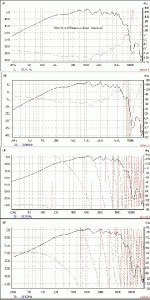OK this should be a reasonably simple question to get answered but when is anything simple with DIY!
Right here goes.
I can measure frequency responses with JMLS, it works brilliantly see pics below. Anywho as you will know if you have MLS there are several ways to measure, one channel, two channel, one channel inverted and two channel inverted.
I am measuring a Vifa C20WJ-19-08 in the box it will be used in.
I am using the wallin jig mk2 with a panasonic WM61A mic capsule and a calibration file from Mikhail. To get the wallin to work with MLS I need to swap the left and right channel to the soundcard. This is from the way loudspeaker workshop uses it.
The mic is 20 cm from the front of the cabinet, the driver is flush mounted, the mic is infront of the driver. The mic is 80cm from the floor, which is the closest reflective surface, so Im using a "length" of 4.6ms which should make measurements free from relections. The MLS length is 8192.
Right well the question is this, which setting do I use out of the above, one chan, two chan, and the inverted. I have included diagrams of a measurement taken with each. As you can see the frequency measureing is consistant which is great. All that changes is the phase with the different settings, which is very important so I need to know which one to use.
The first pic is of one chan non invert
2nd one one chan inverted
3rd two chan non invert
4th two chan invert
Thanks in advance Matt
Right here goes.
I can measure frequency responses with JMLS, it works brilliantly see pics below. Anywho as you will know if you have MLS there are several ways to measure, one channel, two channel, one channel inverted and two channel inverted.
I am measuring a Vifa C20WJ-19-08 in the box it will be used in.
I am using the wallin jig mk2 with a panasonic WM61A mic capsule and a calibration file from Mikhail. To get the wallin to work with MLS I need to swap the left and right channel to the soundcard. This is from the way loudspeaker workshop uses it.
The mic is 20 cm from the front of the cabinet, the driver is flush mounted, the mic is infront of the driver. The mic is 80cm from the floor, which is the closest reflective surface, so Im using a "length" of 4.6ms which should make measurements free from relections. The MLS length is 8192.
Right well the question is this, which setting do I use out of the above, one chan, two chan, and the inverted. I have included diagrams of a measurement taken with each. As you can see the frequency measureing is consistant which is great. All that changes is the phase with the different settings, which is very important so I need to know which one to use.
The first pic is of one chan non invert
2nd one one chan inverted
3rd two chan non invert
4th two chan invert
Thanks in advance Matt
Attachments
#3
It seems that you're wired for two channel which should give you a more accurate reading. It's not necessary to invert the phase if it's passing though zero within the passband of the driver being measured.
It seems that you're wired for two channel which should give you a more accurate reading. It's not necessary to invert the phase if it's passing though zero within the passband of the driver being measured.
I never have used this software, so I don't really know what "one channel" and "two channel" mean. But the top two plots have signal delay from driver to mike subtracted out and the bottom two don't.
In 2 channel mode the mic is connected via a mic preamp to the left line input (Ch1), the right channel (Ch 2) is connected via an input probe to the electrical terminals of the loudspeaker under test. In two-channel mode the analysis of Ch 2 is subtracted from the analysis of Ch1 to provide a measurement that compensates for the FR anomalies in the soundcard and amp.
OK thanks guys that seems to have cleared it up, from what I can make out from your answers I should use two chan non inverted.
- Status
- Not open for further replies.
